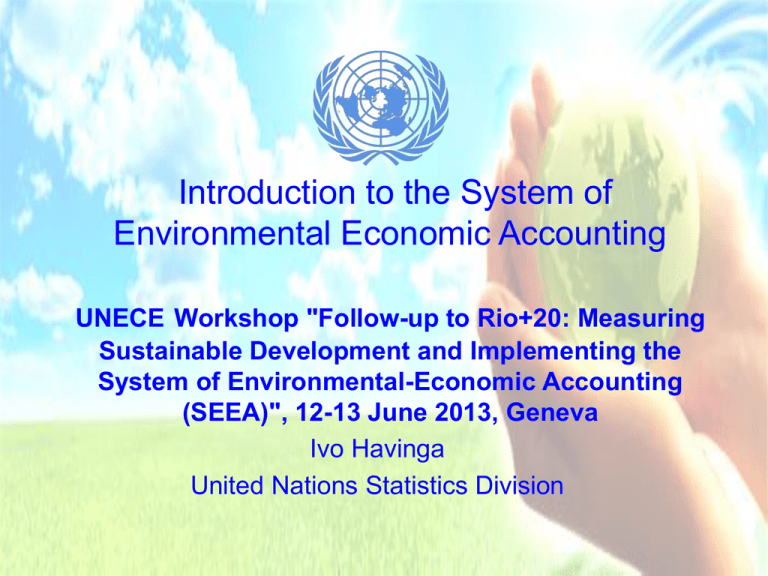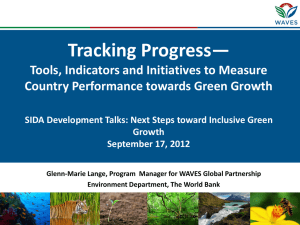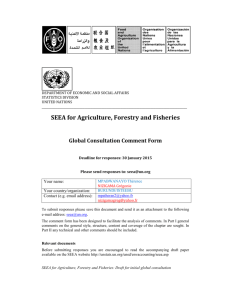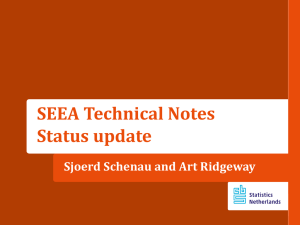System of Environmental
advertisement

Introduction to the System of Environmental Economic Accounting UNECE Workshop "Follow-up to Rio+20: Measuring Sustainable Development and Implementing the System of Environmental-Economic Accounting (SEEA)", 12-13 June 2013, Geneva Ivo Havinga United Nations Statistics Division System of Environmental-Economic Accounting Policy settings Post-2015 UN development agenda/SDGs UNDESA UNEP UNDP OECD initiatives on Green Growth/Green Economy Broader measures of progress/Beyond GDP World Bank Natural Capital Accounting/ WAVES Aichi targets of CBD strategic plan 2011-2020 (e.g. Target 2) UNDP Poverty and environment UNEP TEEB 2 System of Environmental-Economic Accounting Para.38 of the Rio+20 report “We recognize the need for broader measures of progress to complement GDP in order to better inform policy decisions, and in this regard, we request the UN Statistical Commission in consultation with relevant UN System entities and other relevant organizations to launch a programme of work in this area building on existing initiatives.” 3 System of Environmental-Economic Accounting Challenges ahead for our operations Fundamental rethink and transformational change in mainstreaming sustainable development • How we set the statistical agenda, how we keep the agenda under review and how we promote the statistical agenda and the authority of official statistics • How we engage within and between the national, regional and international statistical system with a bottom-up approach based on national priorities • How we integrate policy and statistics in our operations • How we integrate economic, social and environmental dimensions in our operations 4 System of Environmental-Economic Accounting Implications for statistical community A need to bring statistical decisions into the political process of defining development goals, targets and indicators An early and adequate engagement of the statistical community is vital A leadership role for the national statistical offices in the national statistical system and engage with the national stakeholders A need to strengthen the capacity of national statistical systems to compile and report development indicators through balanced and resourced national statistical systems based on national priorities 5 System of Environmental-Economic Accounting Statisticians, politicians and policymakers, business sector, scientific/academic community and general public must join hands! 6 System of Environmental-Economic Accounting The Suite of SEEAs 1993 2003 2006 Handbook – interim publication Updated SEEA handbook – manual of best practices UNSC decided to elevate SEEA to an international standard 2012 SEEA – The Central Framework (internationally agreed standard) Chapter 1 – Introduction to SEEA Central Framework Chapter 2 – Accounting structure Chapter 3 – Physical supply and use Chapter 4 – Environmental activity accounts and flows Chapter 5 – Asset accounts Chapter 6 – Integrating and presenting the accounts 2013 2013 SEEA – Experimental Ecosystem Accounts SEEA – Applications and Extensions Subsystems: SEEA-Water, SEEA-Energy 7 System of Environmental-Economic Accounting Recent advances - SEEA Internationally agreed statistical framework to measure environment and its interactions with economy Adopted as international statistical standard by UN Statistical Commission in 2012 Developed through intergovernmental process Published by UN, EU, FAO, IMF, OECD, WB 8 System of Environmental-Economic Accounting SEEA: A Statistical Standard Countries are “encouraged to implement the standard” International organizations have obligations to assist countries in implementation Implementation strategy adopted by Statistical Commission in March 2013 Data reporting mechanism will be established 9 System of Environmental-Economic Accounting Integrated statistics Linking policy needs and statistics Understanding the institutional arrangements Integrated statistical production process/chain and services Consistency between basic data, accounts and tables and indicators Indicators Accounts SEEA Basic data Economic Environmental Social Statistics 10 System of Environmental-Economic Accounting Integrated statistics Interrelations between economy, environment and society through systems approach – SNA and SEEA Communication and visualization of the story the statistics tell 11 System of Environmental-Economic Accounting The SEEA Central Framework Accounts 1. Flow accounts: supply and use tables for products, natural inputs and residuals (e.g. waste, wastewater) generated by economic activities. • physical (e.g. m2 of water) and/or monetary values (e.g. permits to access water, cost of wastewater treatment, etc.) 2. Stock accounts for environmental assets: natural resources and land • physical (e.g. fish stocks and changes in stocks) and/or monetary values (e.g. value of natural capital, depletion) 3. Activity / purpose accounts that explicitly identify environmental transactions already existing in the SNA. • e.g. Environmental Protection Expenditure (EPE) accounts, environmental taxes and subsidies 4. Combined physical and monetary accounts that bring together physical and monetary information for derivation indicators, including depletion adjusted aggregates 12 System of Environmental-Economic Accounting SEEA Conceptual Framework Territory of reference Environment Imports/Exports Outside territory of reference Economic Units -Enterprises -Households -Government -Non-profit institutions Natural inputs Ecosystem services Economy Activities -Production -Consumption -Accumulation Instruments -Financial/Monetary -Taxes/subsidies - Financing -Resource rent -Permits Analytical and Policy Frameworks -Productivity analysis -Natural resource management -Climate change -Green Growth/Green Economy -Post-2015 Development Agenda Residuals (e.g., emissions, waste) Outside territory of reference Individual Environmental Assets (e.g., land, water, mineral and energy, soil, aquatic) Ecosystem Assets Transboundary Environmental Flows 13 System of Environmental-Economic Accounting SEEA Experimental Ecosystem Accounting Complements SEEA Central Framework Integrated statistical framework for accounting for ecosystem assets and associated services (provisioning, regulating and cultural services) Important first step in development of statistical framework for ecosystem accounting 14 System of Environmental-Economic Accounting Linking ecosystem assets and well-being through ecosystem services Individual & societal well-being Benefits SNA & non-SNA Human inputs (e.g. labour, produced assets) Ecosystem services Ecosystem processes Ecosystem characteristics Intra-ecosystem flows ECOSYSTEM ASSET Inter-ecosystem flows 15 System of Environmental-Economic Accounting Key aspects of the framework Statistical units Classification of ecosystem services • Provisioning (water, materials, energy and other provisioning services) • Regulating services (remediation and regulation of biophysical environment, flow regulation, etc.) • Cultural services (physical or experiential use of ecosystems Ecosystem assets • Ecosystem extent • Ecosystem condition (measured through a range of indicators of characteristics) • Expected ecosystem service flows Degradation and enhancement 16 System of Environmental-Economic Accounting SEEA Experimental Ecosystem Accounting UN Statistical Commission • Encouraged countries to test framework • Endorsed the research agenda • Requested creation of mechanism to advance research agenda – multidisciplinary • 5 possible research streams: ▫ ▫ ▫ ▫ ▫ Ecosystem conditions and services Geospatial Valuation Integration of ecosystems in the accounting framework Policy applications and communication 17 System of Environmental-Economic Accounting The SEEA Policy Quadrants I. People and the environment II. The economy and the environment Sustainability III. Ecosystems IV. Risks 18 18 System of Environmental-Economic Accounting I. Improving access to services and resources II. Managing supply and demand and reducing impacts Sustainability III. Improving the state of the ecosystems IV. Mitigating and adapting to extreme events 19 19 System of Environmental-Economic Accounting Quadrant I: Improving access I. Improving access to services and resources Key information in this (household sector related): quadrant • Costs associated with the provision of services to households • Investments in network infrastructure • Employment and compensation in household production units • Household consumption and disposable income • Poverty and inequality 20 20 System of Environmental-Economic Accounting Quadrant II: The economy and the environment Key information in this quadrant: II. Managing supply and demand • Efficiency of production • Decoupling • Multifactor productivity • Efficiency of consumption • Embedded emissions • Footprint indicators • Costs of production and payments by users (e.g. fees, taxes, rents, permits, etc.) • Employment and compensation • Financing (who pays for investments and current costs) • Depletion estimates • Solid waste and emissions • Environmental protection and resource 21 management expenditures 21 System of Environmental-Economic Accounting Quadrant III: Ecosystems Key information in this quadrant: III. Improving the state of the ecosystems • Ecosystem extent • Ecosystem conditions • Water cycle • Carbon cycle • Nutrient cycle • Primary productivity • Biodiversity • Regulatory services provided ecosystems by 22 22 System of Environmental-Economic Accounting Quadrant IV: Extreme Events Key information in this quadrant: IV. Mitigating and adapting to extreme events • Natural disasters • Investments for mitigation • Investments for adaptation 23 23 System of Environmental-Economic Accounting Reference Material Briefing notes: Briefing note on SEEA Central Framework: http://unstats.un.org/unsd/envaccounting/Brochure.pdf Briefing note on SEEA Experimental Ecosystem Accounting: http://unstats.un.org/unsd/envaccounting/workshops/int_seminar/note.pdf Briefing note on SEEA Water and International Recommendations for Water Statistics (IRWS) http://unstats.un.org/unsd/envaccounting/WWAP_UNSD_WaterMF.pdf Methodological publications: SEEA Central Framework: http://unstats.un.org/unsd/envaccounting/White_cover.pdf SEEA Experimental Ecosystem Accounting: http://unstats.un.org/unsd/statcom/doc13/BG-SEEA-Ecosystem.pdf SEEA Applications and Extensions: http://unstats.un.org/unsd/statcom/doc13/BG-SEEA-AE.pdf Library – searchable library of publications (e.g. country case studies, methodological publications, etc.) http://unstats.un.org/unsd/envaccounting/ceea/archive/ Research agenda accompanying SEEA-Experimental Ecosystem Accounting http://unstats.un.org/unsd/statcom/doc13/BG-SEEA-ResearchAgenda.pdf 24 Contact E-mail: seea@un.org






